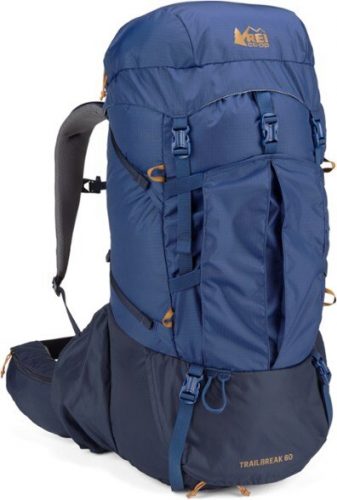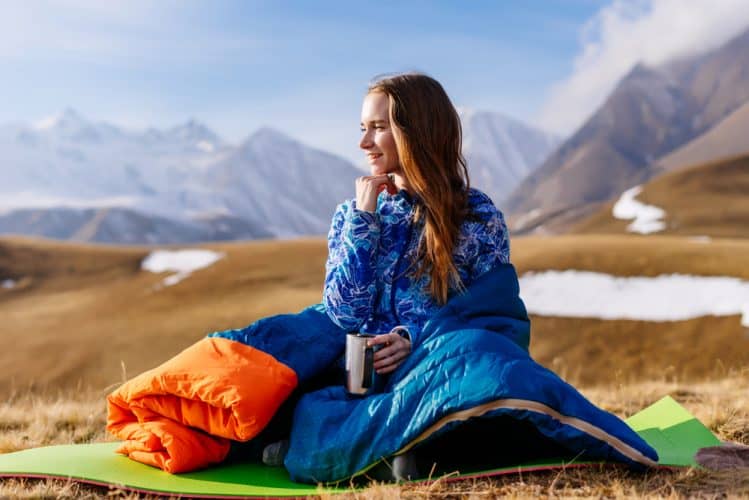7 Elite Hiking Backpacks With Sleeping Bag Compartment
In this article you will learn what are the best hiking backpacks with sleeping bag compartment on the market.
I will also present you with some unexpected benefits of having a dedicated space for your sleeping bag, aside from the boring fact that it keeps your gear organized.
- Our Top Pick: Gregory Paragon
- Popular Choice Osprey Stratos
- Deuter AirContact Lite
- Best budget choice Teton Sports Hiker
- Osprey Atmos AG
We spent 17 hours curating this list. Our only goal was to deliver a comprehensive guide containing not only the top-notch packs right now but also plenty of useful information on their use that you won’t find anywhere else.
We dug deep into their features and specifics to unravel their pros and cons. Like always, we tested some backpacks, while for others we consulted friends who use them on the trail every day.
So if you want to know which packs people use most often on hiking trips right now and stow their sleeping bags, then continue reading.
Tons of valuable information is waiting for you.
Let’s start.
Our Top Picks

- Premium FreeFloat suspension moves with your body
- Hydration sleeve transforms into a SideKick daypack
- Multi-pocketed, lightweight, and robust
- Rain cover is included
- Innovative hip belt that has dual adjustment points
- Multi-directional compression straps for tightening up the load easily
- Floating hood compartment that you can raise to stow extra gear
- Lifetime warranty
Without a further ado, our favorite backpack on this list is #6 Gregory Paragon 58 L.
We look at many factors besides personal preference when we choose a winner of the “Our Top Pick” category.
Some of these factors are the quality of the suspension, ventilation, storage organization, as well as the price and the flaws of the backpack.
We also look at what others say about it to have the full picture. What really impressed us in Gregory Paragon is that it has some truly outstanding trail-friendly features that only a few packs have in that price range.
This pack offers an unmatched balance of carrying comfort, durability, and organization. Plus, it’s lightweight and most importantly, it’s not overpriced.
Last but not least, the sleeping bag pocket is well protected, large, and easily accessible.
Make sure to check this pack in more detail.
Best Hiking Backpacks With Sleeping Bag Compartment: Quick Overview
| IMAGE | PRODUCT | DETAILS | |
|---|---|---|---|
Our Top Pick  | Gregory Paragon |
| View Latest Price → |
Runner up 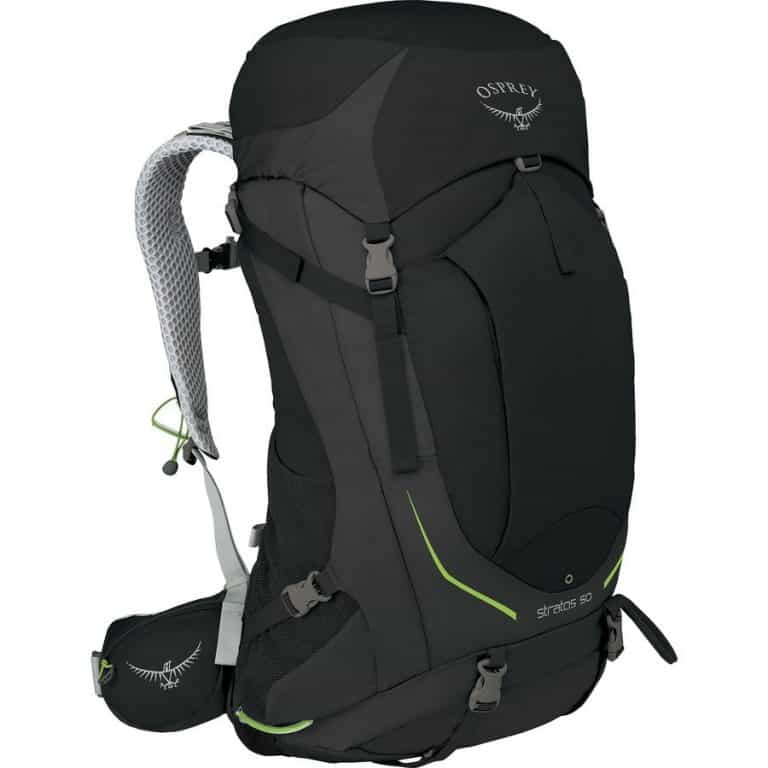 | Osprey Stratos |
| View At Amazon → |
Lightweight 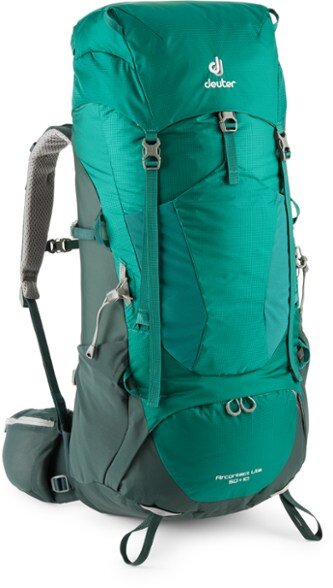 | Deuter AirContact Lite |
| View Latest Price → |
 | Gregory Zulu |
| View At Amazon → |
Super popular 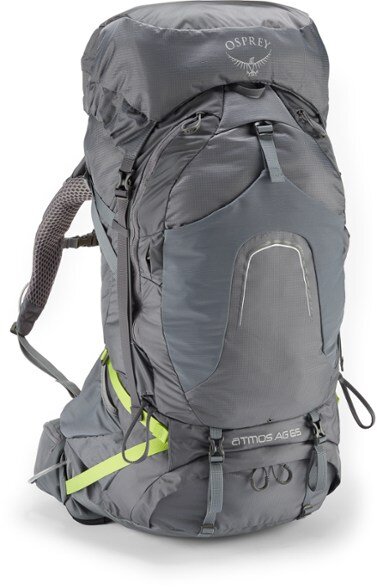 | Osprey Atmos AG |
| View Latest Price → |
Best budget choice  | Teton Sports Hiker |
| View On Amazon → |
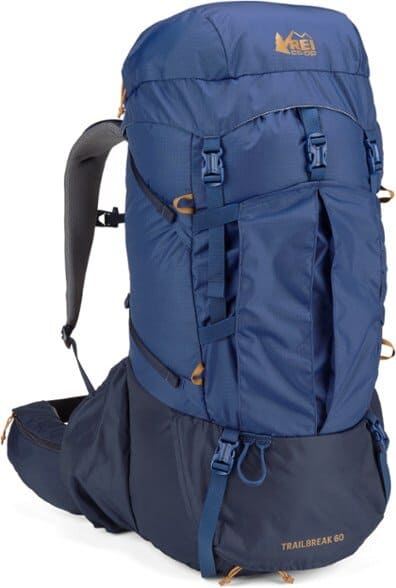 | Rei Co-op TrailBreak |
| View Latest Price → |
#1 Osprey Stratos 50 L
Being one of Osprey’s most successful models, the Stratos is the only feature-rich pack you need to make your 3-6-day trip as comfortable as it could be. The breathable and supportive back panel has the amazing AirSpeed™ suspension that eliminates pressure points and keep the pack away from you back. You’ll love the adjustable torso length as well as the multiple pockets and the practical Stow-on-the-Go walking pole attachment system. And much more. Let’s see it.
I own this backpack and I have first-hand impression of its usability. You might want to read my full review of the Stratos 50.
I first bought the 50 L model because I desperately needed a durable pack for my week-long hiking trips. Then my old daypack tore apart, and I had to think about buying a new one. I was already familiar with the Stratos so with little hesitation I bought the smaller model. Here’s the Stratos 24 daypack review.
In short, what makes me like the Stratos 50 so much is that it’s durable, comfy, and spacious. And it weighs only 3 lbs or 1.36 kg. I carry up to 40 lbs (18 kg) with it.
The sleeping bag compartment is in a zippered bottom pocket. It’s easily accessible and deployable. It also has a divider. You can fit a regular-sized sleeping bag there. Pay attention for bulkier ones, though as they might not fit. It’s always a good idea to have a compressible sleeping bag. I fit mine which is for cold weather and it’s not small. I like to snug in it and stargaze in my tent.
Let’s inspect the major pros and cons of the backpack.
What We Like
What We Don't Like
#2 Deuter AirContact Lite 50 L + 10 L

Image via Deuter.
With an adaptable storage capacity, lightweight design, and efficient carry system, AirContact Lite is one of the jewels in the crown of Deuter. The superb AirContact suspension keeps the weight of the pack close to the center of gravity, thus enhancing load distribution while the ergonomic shoulder straps follow your body movements. Fully adjustable and multi-functional, this pack is highly popular among backpackers worldwide.
The Aircontact Lite is indeed light – only 3 lbs. 14 oz. or 1.7 kg. for a total volume of 60 L. That’s excellent for ultralight hiking and folks who are planning long-distance hiking trips.
Deuter decided to upgrade their ACT Lite series, and this is how they created the AirContact Lite series. This new upgraded AirContact Lite model has some great improvements.
Among the most important ones are the more durable fabric, the thick closed-cell foam on the back panel and on the harness as well as the removable top lid.
What’s great is that the thicker foam and the stronger material don’t add additional weight to the pack. In fact, it’s the opposite. The pack is hydration-ready and with large stretchable water bottle side pockets. And if you don't need your sleeping bag on some trips, you can use the roomy compartment for storing something else.
The sleeping bag compartment is at the bottom side of the pack. It’s zippered, and it has a zippered divider. You can unzip it and have full access to the main compartment of the rucksack. The size is decent – 9” x 11” x 9” or 23 cm x 28 cm x 23 cm. You can store pretty much any sleeping bag.
Let’s outline some of the most important aspects of the backpack.
What We Like
What We Don't Like
#3 Gregory Zulu 55 L
Another star in the hiking hall of fame, Gregory Zulu strikes with functionality and well thought out trail features. The pack has the FreeFloat dynamic suspension with pivoting hip belt, quick access side water bottle holders, and OpenAir technology on the back panel that provides exceptional ventilation. Moreover, it has 6 exterior pockets and comes with a rain fly. Check it out!
The Zulu provides enough well-organized space for a long weekend trip. What you’ll first notice when you put the Zulu on your back is how stable it sits.
That’s thanks to the perimeter alloy frame that has a fiberglass anti-barreling cross stay. It’s able to hold big loads on a vertical plane with no shifting.
The user reviews report that the pack is quite sturdy and withstands years of rugged usage. That’s not a surprise for a brand like Gregory. They use only top-notch fabrics. The Zulu is made out of 201D high-tenacity nylon.
The sleeping bag sleeve is zippered and you’ll find it at the bottom of the pack. It’s very roomy and similarly to many other packs, it has a divider. You can easily remove it and gain access to the main compartment of the backpack.
The pack comes in two sizes – S/M and M/L. No matter which you choose, you’ll be able to adjust the fit by 4” thanks to the adjustable torso length. That gives you enough freedom.
The weight of the Zulu is 3 lbs. 9.3 oz or 1.62 kg. for the S/M size, which is awesome given the volume of 55 L. The pack doesn’t feel heavy because it’s not heavy.
Let’s check out the pros and cons.
What We Like
What We Don't Like
#4 Osprey Atmos AG 65 L
Multi-award-winning and with thousands of 5-star reviews, for many hikers the Osprey’s Atmos AG is the ultimate choice for a long-hauling backpack. It has the upgraded Anti-Gravity ventilated back panel, fully adjustable and ergonomic harness, and 11 exterior pockets. Let’s examine it closely!
For a long time, the Atmos AG has been a gold standard in backpack manufacturing. And it continues to be. That’s because the artisans at Osprey continuously improve its features and design to meet even the highest expectations.
This 2018 model has some enhancements including reinforcement on stress points for more durability, better fit adjustments, and a new color.
The pack comes in three sizes, each one having an adjustable torso length. You can modify the length by 3”. To give you an idea of the maximum fit, the L version adapts to torsos up to 23” (58.4 cm).
You can carry up to 50 lbs of load with this pack but the maximum recommended number is 40 lbs. Otherwise, it gets uncomfortable and you’ll wear it out more easily.
The sleeping bag compartment is situated at the bottom of the pack in a zippered pocket. It has a divider and by removing it you can reach the main interior. The sleeping bag space is capacious. Its dimensions are approximately 15” x 11” x 8” or 38 cm x 28 cm x 20 cm.
The Atmos AG is quite robust incorporating 630D dobby nylon and 420 high density nylon. The weight of the backpack depends on the size – the Medium version which is 65 L weighs 2.06 kg. or 4 lbs. 9 oz.
Don’t hesitate to read some user reviews here.
Now let’s see some cool stuff about the famous Atmos AG.
What We Like
What We Don't Like
#5 Teton Sports Hiker 60 L
Here’s your perfect budget-friendly choice! This versatile and ultralight backpack offers some outstanding features for an unbelievable price. With tons of straps and pockets, an integrated rainfly, reinforced padding on the lumber area, and fully adjustable fit, Teton Sports Hiker is a great bang for the buck. See it for yourself.
Known for their affordable outdoor gear, this is one of Teton Sports most popular packs. It’s a fantastic deal for those looking for a cheap hiking backpack for 3-6-day trips. In fact, you can also take a look at our Teton Sports Scout 3400 review to get yourself familiar with the brand.
The Hiker model offers impressive durability combined with decent carrying comfort and ventilation. It weighs only 4 lbs. or 1.8 kg., which is OK for its size and capacity.
The sleeping bag compartment is at the bottom of the pack. It’s zippered and really roomy. Like with other fancier packs, it has a divider that you can unzip to gain access to the main compartment of the pack.
It’s a top loading backpack with a drawstring closure under the lid. You can also access the main compartment via the sleeping bag pocket at the bottom.
Let’s jump to some important highlights.
What We Like
What We Don't Like
#6 Gregory Paragon 58 L
Effectively balancing weight and performance, and featuring tons of backpacking-friendly features, Gregory Paragon is a great option for long weekend trips. The updated model has the innovative FreeFloat suspension, a hydration sleeve that can be used as a daypack, anatomically adjustable harness, and well thought out organization options. Others love it, you’ll love it too!
The Paragon comes in two sizes (S/M and M/L), each allowing a 4” torso length adjustment. So you can choose based on the length of your back. The M/L version fits torsos up to 22” or 56 cm.
It’s a top loading pack with a floating lid that could be expanded or completely removed, depending on the load you want to carry.

Some really small but important features that you appreciate out there on the trail are the integrated rain cover that stores in a zippered front pocket and the scratch-free stow system on the shoulder strap that allows you to attach your sunglasses.
Besides being a hydration-ready pack, the Paragon is also solar-ready. There are ties on the top lid where you can attach a Goal Zero solar panel and harness energy. Pretty neat, isn’t it!
As usual, the sleeping bag compartment is at the bottom of the pack. It’s big, and it has a divider attached with toggles. When you remove the divider, you automatically have second access to the main compartment. A cool thing is that you can use the divider as a cover to protect the main opening of the pack in cases when you remove the floating top lid.
The weight of the S/M version of the pack is only 3 lbs. 8 oz. or 1.58 kg. Given its capacity, we can safely say the Paragon is a lightweight backpack.
Plus, you can strip off more weight by removing the top lid and the included day pack.
Now, here are some important aspects you need to know about the pack.
What We Like
What We Don't Like
#7 Rei Co-op TrailBreak 60 L
Yet another adjustable-length pack for your long weekend outings, the Trailbreak offers above-average performance at a decent price. Lightweight and durable, this buddy is hydration-ready and its design allows it to support heavy loads pretty well. Plus, it contains environmentally sustainable bluesign® fabrics.
Note that this is not a fancy pack equipped with numerous state-of-the-art features. And honestly, sometimes that’s a relief. Instead, the Trailbreak strikes with minimalistic, yet efficient enough design that gets the job done.
The sleeping bag compartment is pretty big and you can easily fit a winter bag there. The pocket found at the bottom of the pack is zippered and has a detachable divider. Removing it (using the toggles) will gain you access to the interior of the backpack.
What’s interesting is that REI manufacture their packs with textile that’s not only hard-wearing but eco-friendly. The rip stop nylon on the Trailbreak is Bluesign-approved meaning that creating it had a minimum impact on people and environment.
Weighting only 3 lbs. 13 oz. or 1.73 kg, those who prefer to hike with minimum weight will certainly appreciate the pack.
It’s a one-size, top-loading rucksack. You can comfortably carry up to 30 lbs. / 13.6 kg. of load with the backpack. Some say it’s even more, but it’s never a good idea because the pack becomes too bulky and stiff.
Let’s examine the Trailbreak in more detail.
What We Like
What We Don't Like
What To Look For When Choosing A Pack With A Sleeping Bag Pocket?
At first sight, you might think that picking a backpack that has a dedicated space for your sleeping bag is pretty straightforward.
While that’s true, there are still some important things to consider. You don’t want to make the wrong choice, do you?
First, look at the size of the compartment. Will it fit your sleeping bag? Most brands adapt that space to fit the most common bag sizes. Plus, the pocket is usually stretchy enough allowing you to stuff your bag. Otherwise you'll have to learn how to attach a sleeping bag to a backpack.
However, you might have a really bulky winter bag that makes you wonder about if it will fit. Hm…
In such cases, don’t hesitate to contact the manufacturer and ask for the exact size of the pocket. Even though it’s rare that you see that on the product spec sheet, the manufacturer will provide you with that information.
Sure enough, you’ll have to measure your sleeping bag beforehand. If you’re buying a new one, it’s pretty much sure that you’ll find its dimensions in the product spec sheet.
Second, avoid packs with pockets that close with a Velcro. It’s They don’t offer the same level lf protection as zippered ones and it’s easier to break and wear out.
You need a sturdy zippered sleeve that will encapsulate your bag and protect it from the elements. Which brings us to the next point.
Another important aspect that you don’t want to overlook is water resistance. Unless you’re storing your sleeping bag in a dry bag for hiking, you have to make sure that the pack offers protection against moisture and wetting,
The fabrics on most of the high-quality backpacks are water resistant but still not fully waterproof. And that would be a problem if you’re hiking in bad weather for several hours. You might be interested in checking out our list of the top hiking packs that are waterproof.
Imagine the feeling to sleep in a soaking sleeping bag. I’ve done that and it’s not pleasant. That’s why look for backpacks that have an integrated rain cover. If they don’t, then purchase one separately.
Last but not least, it would be a nice addition for the sleeping bag compartment to have a removable divider. That will not only separate your bag from your other gear, such as you cold weather leggings, for instance.
It will make it super easy to access, and it will also allow you to have additional access to the main interior of the pack from the bottom (where usually the sleeping bag compartments are located). The more access points to your items, the better, right?
3 Practical Benefits Of Sleeping Bag Compartments
Those pockets are more useful than you think. Let’s see their advantages and understand why people are buying such packs more and more.
Better Organization
That’s a no-brainer. Your sleeping bag is stored in a space that’s dedicated only for it. And you know exactly where it is. Period. In that way you don’t have to frantically rummage through your stuff while trying to find the bag which is usually at the bottom.
Having your bag in a separate pocket is crazy useful when you have to set up camp quickly. Sometimes that’s necessary when a storm occurs, for example. In such cases, you want to leave your other gear in the pack and pull out only the sleeping bag.
Not to mention that you can stuff other things in that pocket too no matter if you bring your sleeping bag or not. For instance, when I don’t take my bag, I put my hammock in that pocket, plus some extra t-shirts. And I have quick access to them.
Better Support, Enhanced Carrying Comfort
In most of the cases, the sleeping bag pocket is located at the bottom of the backpack, near the lumbar area. Having something cushioned there to support your lower back maximizes your comfort when walking.
More Protection For Your Sleeping Bag And Your Other Gear
When your expensive goose down bag is attached on the exterior of your pack, it’s exposed to the elements. It absorbs moisture and dust, which is damaging it.
In addition, it’s more difficult to walk on technical terrains when your bag is shifting on the outside of your bag, thus disturbing your balance.
Also, it would become a mess to put your sleeping bag together with your dirty clothes and vice versa.
FAQ
Faq
Are packs with sleeping bag compartment more expensive than others?
Am I sure to fit my sleeping bag in the dedicated space?
Is my bag fully protected in that compartment?
Conclusion
Now you have a complete list of some truly outstanding packs with a dedicated sleeping bag sleeve and their best use and benefits.
I hope you have an exciting time out in nature. Have fun and enjoy your adventure.
Asen Stoyanchev
Founder of this website, Asen is a passionate hiker and writer who is also a gear nerd. He’s been featured on many established hiking websites where he gives hiking advice & tips. When he is not trekking with his family or friends, he is writing articles and product reviews. Asen spends most of his time in Bulgaria but he constantly travels the world in seek of more unforgettable experiences. Read more about Asen here.







